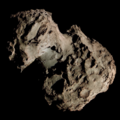 Comet Ikeya (1964f) photographed by Dennis Milon on 27 July 1964 | |
| Discovery | |
|---|---|
| Discovered by | Kaoru Ikeya |
| Discovery date | 3 July 1964 |
| Designations | |
| 1964f | |
| Orbital characteristics [1] | |
| Epoch | 1964-Jul-28.0 |
| Observation arc | 56 days |
| Number of observations | 36 |
| Aphelion | 110.97 AU |
| Perihelion | 0.822 AU |
| Semi-major axis | 55.90 AU |
| Eccentricity | 0.9853 |
| Orbital period | 418 years |
| Inclination | 171.92° |
| 269.95° | |
| Argument of periapsis | 290.77° |
| Last perihelion | 1 August 1964 |
| Earth MOID | 0.041 AU |
| Jupiter MOID | 0.267 AU |
| Physical characteristics | |
| Comet nuclear magnitude (M2) | 16.0 |
| 2.7 (1964 apparition) | |
C/1964 N1 (Ikeya), also known as Comet 1964f, is a long-period comet discovered by Kaoru Ikeya on 3 July 1964. The comet last passed perihelion on 1 August 1964, when it reached an apparent magnitude of 2.7. [2]

